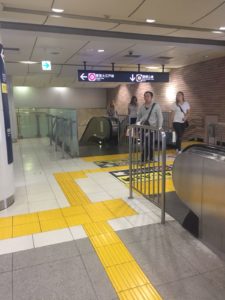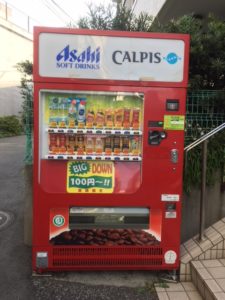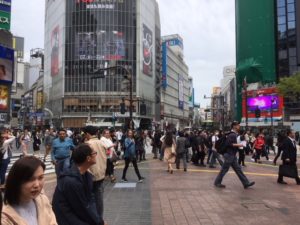
Yasu furnished us a pictorial guide of the route to his Airbnb
Third in a Series
Arriving in the Shinjuku train station, Tokyo’s busiest, can be a bit intimidating, especially after a trans-Pacific flight with little sleep and in the middle of rush hour.
An unfailingly polite people in every other way, Japanese commuters plow through the station like bullet trains, with little deference to gobsmacked tourists staring in bewilderment at the maze of signs and passageways. These folks appeared to be on a mission, and accomplishing that mission — getting to wherever it is they’re going — wasn’t about to let us stand in their way.
If you don’t like crowds, you might want to avoid Tokyo — the world’s largest metropolitan area at nearly 38,000,000 people — and beat a quick retreat to the Japanese countryside.
Fortunately, our Airbnb host, Yasu, had provided us with a video of where to exit the train station, locate our subway line, and, after one stop, follow the exact route to our accommodation, just three minutes’ walk from the nearest Metro station.
We had a moment of panic when the video suddenly disappeared from my wife Catharine’s iPhone, but then it magically reappeared and all was well.
Little, Small, Tiny
We found our way to a quiet tree-lined neighborhood street across from a park, past a grocery store (“Fine Food, Better Life”) and down a hill, past a number of vending machines that dispensed drinks of various sorts.
When we arrived at a bright red vending machine that Yasu had labeled a landmark, we knew to turn up the stairs of a small apartment building, get the key from the mailbox, and make our way up three flights, dragging the carry-ons that we were grateful were small and light.

The red vending machine was our key landmark
Our little apartment had all the necessities: a small, comfortable bed and additional bedding for the floor, a tiny w.c., a separate shower and sink, a little balcony, a small fridge, a small washing machine, a small stove, a kettle, and a little container of Nescafe for the first shot of morning brew.
You’ll notice a pattern here: “little,” “small,” “tiny.” Generally speaking, at six feet tall, I felt very big in Japan — a bit too big.
But we also felt very Japanese, taking off our shoes at the entrance, for instance, and exchanging them for the slippers provided. I was amused to find a separate pair of slippers stationed in front of the toilet, since the w.c. was so tiny you couldn’t take one step within it.
But, as we were to discover throughout Japan, a separate pair of slippers were always provided for toilet use, except in the two Western-style hotels we stayed in.
Settling In
Yasu’s Airbnb would be our retreat for the next four nights, and it served us well as we explored Tokyo.
We got to know the neighborhood almost like natives, shopping daily at Fine Food, Better Life, where we picked up dumplings, rolls, sushi and other items for breakfasts and snacks (the prices were reasonable compared to restaurants); watching schoolchildren, all with uniforms and backpacks, make their way through the park on their way to classes; and dodging the many bicycles that everyone rode on the sidewalks.
Somehow, no cyclist ever ran into us or anyone else we saw, a bit of wizardry we admired but which never made us feel safer as they brushed right past us without warning from behind.

Tokyo, with a metropolitan population of 38 million, is not for the crowd-phobic
We learned to walk or stand on the left side of sidewalks and escalators, just as Japanese motorists drive on the left side, except on those occasions when, mysteriously, everyone on the sidewalks or escalators would shift to the right.
We ate at neighborhood restaurants, many of them serving Korean barbecue in this part of the city, but also classic tiny grandmother-run Japanese places with no English menus — which was OK, because all they served were delicious bowls of soup noodles anyway. The worst thing that could happen is you’d end up with homemade udon noodles instead of homemade soba.
Masks, Masks, Everywhere
And we puzzled over the Japanese predilection — perhaps one in ten people of all ages — for wearing white surgical masks over their noses and mouths.
Though I had seen the same thing in other East Asian countries, those masks seemed more tied to very real threats of air pollution (China, Taiwan) and various epidemics (such as SARS back in 2003 and bird flu a few years later) — even though they don’t actually provide all that much protection.
The Tokyo air seemed clean enough and we didn’t hear a lot of coughing or sneezing on subway trains.
It turns out that wearing masks has roots dating back more than a century — including long-past flu and other viral epidemics and air-despoiling volcanic eruptions and earthquakes, as well as more recent polluting factory and automobile emissions.
Today, some young women use them as something like veils to ward off unwanted advances, but men — including businessmen in suits — also don them.
We even saw a masked woman posing with her family for a photo until the photographer suggested she lower it; it hadn’t occurred to her.
Fortunately, the crime rate in Japan is very low — in fact, I’ve never felt safer in a major city than in Tokyo, at least when a bicycle wasn’t whirring past us — so wearing a mask isn’t associated with robbery or deliberate disguise as it is in the U.S.
But I’d be hard pressed to identify someone wearing a surgical mask whose intent was to pull off a bank job, being completely inconspicuous as he or she waited in line to rob the teller.
That’s a scenario that probably doesn’t even occur to the Japanese, who leave their bicycles outside at night, unlocked — though I’m surprised more American bank robbers haven’t flocked here.
I read somewhere years ago that no two cultures are more opposite than American and Japanese. The general idea was that Americans worship individualism while Japanese value the needs of society over all.
But it goes beyond that — all the way to offering special slippers for the toilet, living in tiny but exceptionally tidy apartments, and normalizing the idea that a tenth of the population can wear surgical masks with nary a peep from the local constabulary.
In fact, we even saw some some policemen wearing the masks.
If you want to experience a truly different — though technologically advanced — culture, this is the place.
Our journey in Japan would make for a fascinating two weeks.
Photos by Catharine Norton
Next Up: The Vibrant Allure of Tokyo, Japan
For the first posts in my Japan series, see:












Leave a Reply